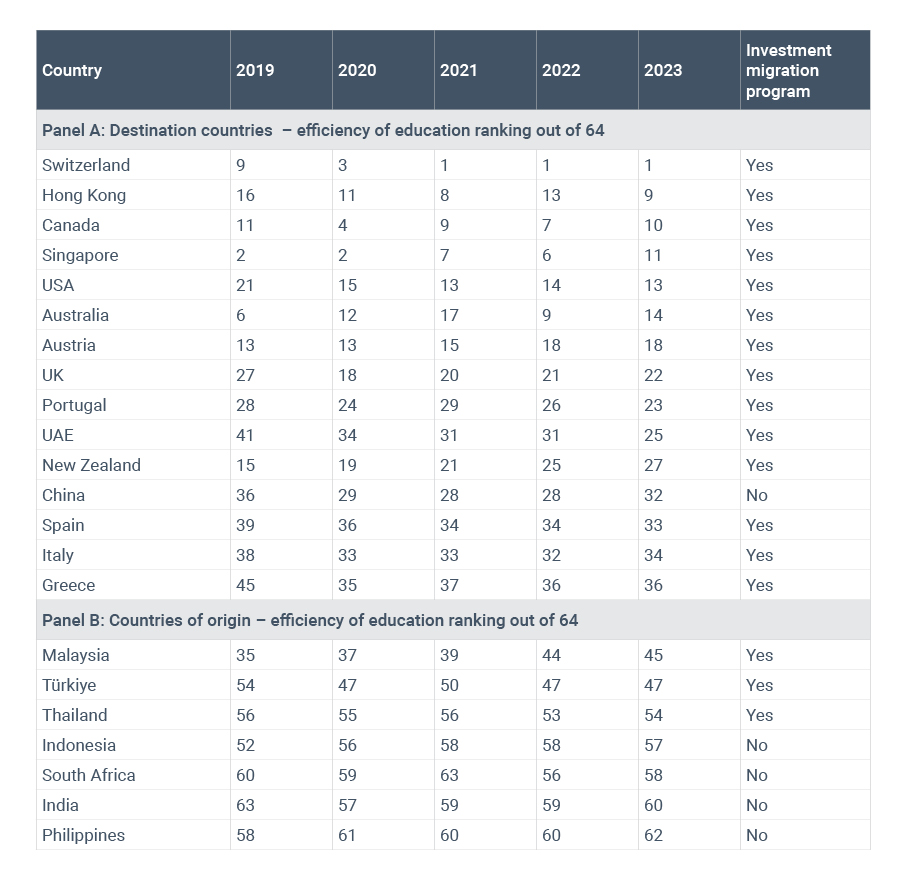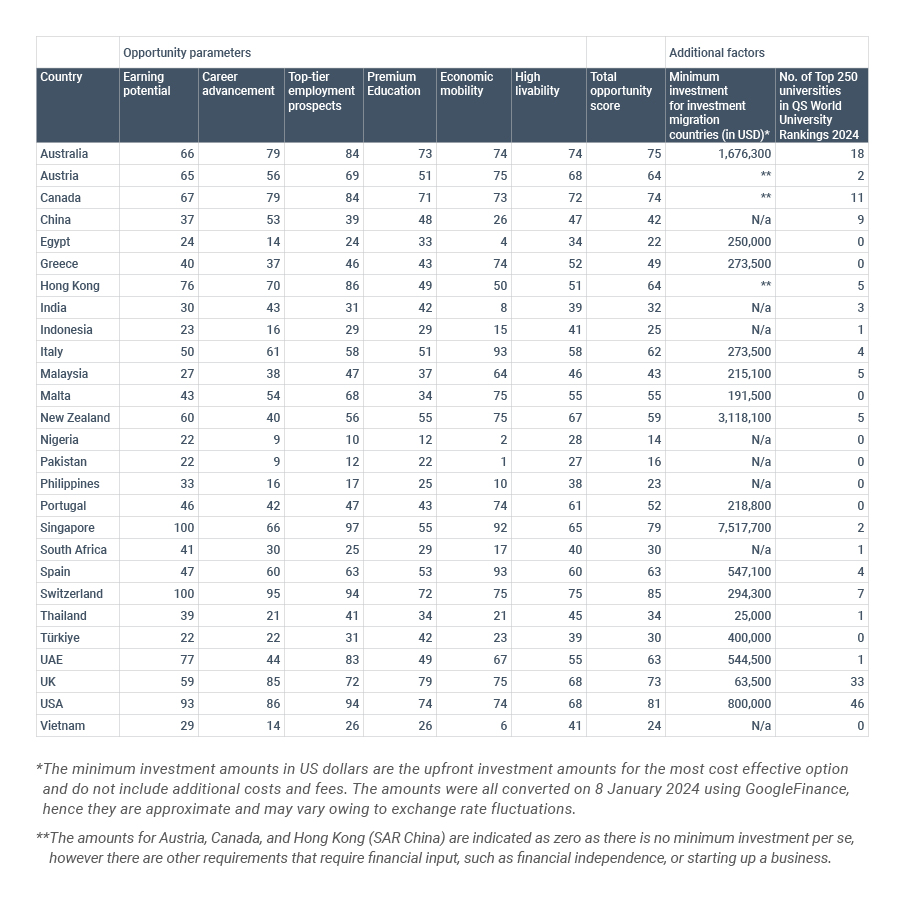
Dr. José Caballero is the Senior Economist at the IMD World Competitiveness Center.
Countries with established investment migration programs (IMCs) have the potential to offer a wide range of opportunities for the children of individuals who opt for them. Such opportunities include access to efficient education systems and professional development. Contrary to students who attend schools or universities on student visas and must return to their countries of origin or engage in lengthy and complicated post-graduate work permit application processes, children of investment migration participants can more easily remain in destination countries and enjoy the advantages of local labor markets. In other words, there is a cumulative effect of investment migration. Such an effect may go beyond pure financial benefits and access to education to include, for example, better quality of life.

To identify optimal destination countries, we use a measure of the efficiency of the education systems in countries included in the Henley Opportunity Index in the Henley Education Report.1 The measure assesses the efficiency of a country’s education system by considering the level of investment therein, the quality of education (as measured by the pupil–teacher ratio), student mobility, and the quality of the “output” of the system, for example, the level of higher education achievement in the country. Using the 2023 ranking of the education measure presented in Table 1 (all rankings are out of a maximum of 64 countries), we classify the countries covered in this report into countries of origin and destination countries.2 Countries of origin are those economies that rank low in the education efficiency measure and thus residents of such countries considering participating in an investment migration program can thereby grant additional benefits to their children’s education and future careers. Destination countries are those which have developed highly efficient education systems (or have improved them in the last five years) and thus offer not only strong educational opportunities but also greater career prospects to students.

Table 1. Countries of Origin and Destination, by Efficiency of Education 2023
Source: The IMD World Competitiveness Ranking 2023 (accessed 16 January 2024)
As Table 1 shows, with the exception of China, all destination countries are IMCs. As they fall in the lower positions of the education efficiency measure, Malaysia, Türkiye, and Thailand are considered as source countries despite being IMCs. Nevertheless, as evidenced below, even parents from China can improve their children’s education and/or career prospects by undertaking an investment migration program in some of the other destination countries.
Using indicators built by Henley & Partners, Table 2 presents different potential benefits for children offered by all the countries (IMCs and non-IMCs) included in this report. Such benefits are measured by different parameters (for example, career advancement, top-tier employment prospects, and economic mobility), which are aggregated into a total opportunity indicator. All scores in Table 2 are out of a maximum of 100, with the exception of the minimum investment and the number of universities in the top 250, which are expressed in absolute values. The methodological and definitional details about all parameters in Table 2 are presented in the methodology section of this report.

Table 2. Parameters of the Cumulative Effect of Investment Migration
Sources: Opportunity parameters: The Henley Opportunity Index; Minimum investments: Henley & Partners; No. of universities in Top 250: QS World University Rankings 2024
To reveal the cumulative effects of investment migration, we will use a hypothetical case of a couple from Indonesia who are contemplating an investment migration program and how such an investment will benefit their child. Entering into an investment migration program in Portugal (with a minimum investment of EUR 250,000, approximately USD 218,800) would give their child access to premium education moving from a local score of 29 to a 43 within a context with much higher standard of living (that is, for example, a better health system, a higher quality of life, and improved personal security) as Indonesia achieves a score of 41 and Portugal 61 in the high livability parameter. As the child grows older, in terms of career advancement (Portugal 42 versus Indonesia 16), and top-tier employment prospects (Portugal 47 versus Indonesia 29), Portugal offers far better prospects and over time will offer greater earning potential and enhanced economic mobility (that is, the ability to easily move to other countries in search for better employment opportunities), with scores of 46 and 74, respectively in those two parameters, than Indonesia, which scores 23 and 15, respectively. Moreover, Portugal achieves a total opportunity score of 52%, compared to Indonesia’s 25%. A move to Portugal will be, thus, highly beneficial for the child.
Continuing with the same hypothetical case, the parents decide that greater opportunities for their child’s professional development are fundamental for their investment migration strategy. Therefore, they are willing to consider an increase in their initial investment and contemplate Spain as destination country, which requires an initial investment of EUR 500,000, approximately USD 547,100). In doing so, they greatly improve the overall prospects for their child. Spain, for example, offers much higher career advancement opportunities (60), top-tier employment prospects (63), economic mobility (93), and greater access to premium education (53) than Portugal does, with similar scores for high livability (60) and earning potential (47), achieving a total opportunity score of 63%. While Spain also offers access to four top global universities, Portugal offers no access to such institutions.
In the case of China, the accumulative value of investment migration becomes clear once we assume that a couple opts for Canada. Such an investment would present their child with much greater access to premium education (China scores 48 and Canada 71), earning potential (China 37 and Canada 67), career advancement (China 53 and Canada 79), top-tier employment prospects (China 39 and Canada 84), economic mobility (China 26 and Canada 73), and high livability (China 47 and Canada 72) than if they remained in China.
It is also possible to achieve such cumulative value among IMCs. For instance, parents from Hong Kong opting for Switzerland would provide their child with greater opportunities across all parameters than if they were educated and employed in the city. For example, Switzerland’s earning potential score is 100, career advancement is 95, top-tier employment prospects is 94, and economic mobility is 75, compared to Hong Kong’s 76, 70, 86, and 50, respectively. Furthermore, while Hong Kong’s total opportunity score is 64%, Switzerland’s is the highest overall at 85%.
The cumulative effect of investment migration, therefore, arises from the fact that such programs enable parents to migrate their children to IMCs through permanent settlement. In doing so, parents can provide greater education and professional opportunities to their children without the hassle of having to acquire a student and/or postgraduate visa. Those opportunities include access to premium education, greater opportunities for professional development, to live in an environment with high quality of life, greater earning potential, and easier mobility across borders. Such access and opportunities can facilitate the sustainability of family prosperity through greater probabilities of wealth creation and preservation by empowering the next generation with a more robust set of skills and capacities.
Notes
1 This measure is one of the subfactors of the IMD World Competitiveness Ranking, namely the education subfactor. For details about the subfactor see the IMD World Competitiveness Ranking 2023 (accessed 16 January 2024).
2 The education subfactor includes all countries covered in this report with the exception of Egypt, Malta, Nigeria, Pakistan, and Vietnam.